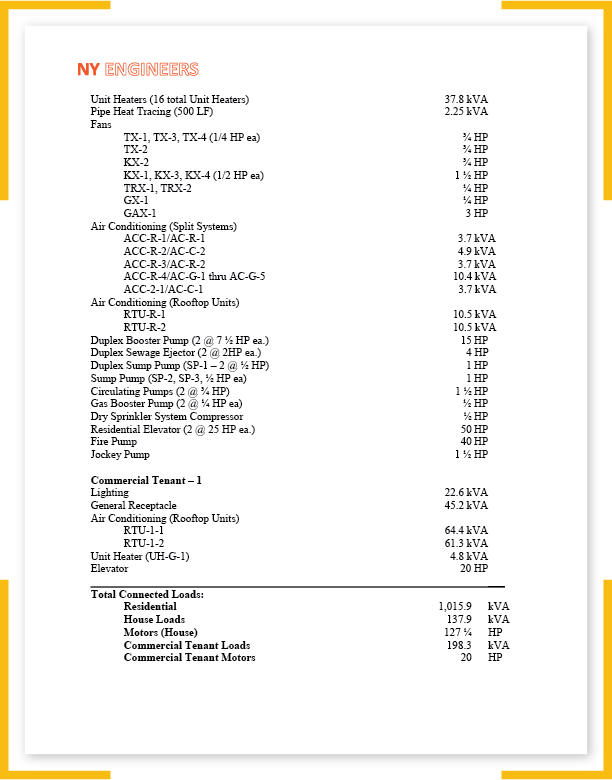Electric Load LETTER
5 Days- That's a Lightning Fast Turnaround Time!
1
Upload Files and Pay
Upload PDF or CAD files, and pay to start the process. An engineer is auto-assigned to your project.
2
Document Review
An engineer will review all the documents shared and connect with you if anything else is required. Initial work starts.
3
Work Starts
Actual design/ report creation work begins.
4
Quality Check
The design and report are checked by the project manager to make sure 100% quality work is delivered.
5
Delivery
The design/ report is delivered to you.
NEED HELP OR ADDITIONAL INFORMATION?
CALL US NOW
(646) 776-4010Get Your Electric Load Letter In 3 Easy Steps
0%
Sign the lease document by acquiring load letter within
5 days
Assess the load of the equipment accurately
0 Errors
Get approval from Con Ed and other agencies
All in One Go
Get load letter for office, retail, restaurant, education
All Occupancy Types
$ 750
per load letter
Documents Required
Architectural plans, HVAC & plumbing equipment list/photos (with model numbers), and kitchen equipment specifications/cut sheets are required.
Delivery Time & Standards
We deliver your report (digitally) within 5 business days as per NEC standards.
What's not Covered
This service does not cover site visits, stamping, DOB/DEP filing, and more than 2 minor iterations.
Service Constraint
The service fee is limited to area up to 3,000 sq. ft.*.
$750*
Per Load Letter


Get your electric load letter at lightning speed.


Accurately evaluate the equipment's load with precision.


Get load letter for office, retail, restaurant, education, etc.


Get approval from Con Ed and other agencies.
WRITTEN CONFIRMATION OF ELECTRIC SERVICE ADEQUACY
Match Load with Equipment
Requirements for electrical loads within buildings will determine the size of the electrical service required. If the load is too high, the electrical service will need to be expanded to increase the available load. Alternatively, the equipment may need to be reconsidered and revised.
Accurate Load Calculations
It is essential that all load calculations are 100% accurate to avoid any possibility of short circuits, arc faults, and even electrical fires. Our technical staff will assess every item of equipment on your list with precision and accuracy. Lighting, water and space heating equipment, heat pumps, computers and so on are included.
Suitability of New Premises
If you’re moving into new commercial premises or even a large residential property, landlords often require an electric load letter to make sure there is sufficient electrical capacity for the equipment you plan to use. If it isn’t sufficient, the supply and distribution may become unbalanced and unstable.


Our on-demand engineering expert
Still not sure about how to proceed?
YOU CAN WRITE TO ME AT inquiry@ny-engineers.com

While the wires that deliver power to the buildings we use are called lines, once the power is in the building, it’s known as the load. So, all the equipment we use in our homes and businesses draw power from within the building and it is essential that the network doesn’t exceed the load. If it does, the electricity is likely to trip and you’ll have a blackout in your premises, if not in the whole building – which is why landlords are so concerned that the equipment you plan to use won’t overload the system.
One of the problems is the age of many of our buildings. Take New York where many historic buildings were built in the late 19th and early 20th centuries. While the buildings themselves have great value in terms of real estate, there are enormous challenges when it comes to electrical issues.
Even if buildings were constructed with state-of-the-art electrical reticulation systems at the time, technology changes quite rapidly, and it is common to find buildings, particularly commercial buildings, that were built decades ago that don’t meet the requirements of the kind of electric loads we need today.
Some of the equipment that demands specific loads include heating equipment, chillers, air handling units, lighting, and the full range of office equipment including computers and servers.
Just think how times have changed. For instance, not that long ago computers and the equipment associated with them was located in centralized locations. Today, most employees have their own computers, unless they are doing menial tasks, and many have laptops that they move between various work environments. Additionally, because electric loads were essentially continuous, load profiles were reasonably predictable, in many situations operating between fixed (usually daylight) hours.
Every electrical system in a building has electrical circuits that are designed to use a certain amount of electricity, but those in older buildings simply don’t meet the needs of our contemporary world.
The reality is that if the wiring hasn’t got sufficient capacity for the projected load, it won’t be suitable for the intended occupancy. This means the landlord will either have to upgrade the electrical infrastructure or the prospective tenant will have to find more suitable premises.
But first, it is essential to find out what the electric load will be once you move in with all your appliances and equipment. An electric load analysis or estimate will determine the maximum capacity that will be required.
Estimating electric loads clearly depends on the appliances and equipment that are going to be used in the building, which is why this information is required in an electric load letter. But, as discussed above, the building itself will also have an impact.
Our certified electrical design engineers can do electric load estimates of buildings, so that owners and landlords know in advance what electrical capacity the building offers. Of course, if the building is new, it is designed for the maximum capacity that will be required.
Whichever way round it is done, electric load estimates require a thorough analysis of everything that relates to the electrical system. Factors that impact on load include:
- Demand - which is determined mathematically as a ratio of the maximum possible demand over the total connected loads of the electrical system. Maximum demand is defined as the total demand of the electrical system for specified intervals of times.
- Coincidence - which is the ratio of the maximum demand over the total individual maximum demands of the subdivisions. Even though electric loads don’t often happen simultaneously, there is a degree of diversity, which is why the coincidence factor is relevant.
- Diversity - which is a factor that is regarded as the reciprocal of the coincidence factor. Mathematically, it is calculated as being the ratio of the individual demands over the maximum demand of the whole system. So, while the demand factor is all about individual loads, the diversity factor applies to groups.
- The load factor - itself is the average electric load that occurs over a particular period of time over the maximum load that occurs during that designated period.
There are several different methods of estimating electric load which include preliminary calculations that involve space-by-space and building area methods (in new design) as well as National Electrical Code (NEC) load and final code calculations.
Of course, the NEC sets the foundation for electrical safety in the U.S. Formulated to protect people and property from all types of electrical hazards, it covers all sorts of emergency issues including emergency disconnects, surge protection, and grand-fault circuit interrupter protection. Ultimately, it is the benchmark for safe electrical design, installation, and inspection.
It is a highly technical subject that is usually tackled by certified electrical design engineering firms like NY Engineers.
Electric load calculations are performed in the context of the NEC and whichever building code and/or National Fire Protection Association (NFPA) code is relevant in terms of where the premises are. So, for instance, if you are in Chicago, it will be NFPA 70: National Electrical Code with Chicago Amendments, and in New York it will be NFPA 70: National Electrical Code with New York Amendments.
Even though the newly released NFPA 70: National Electrical Code 2020 is more up-to-date, it obviously doesn’t contain local information. When tackling calculations though, the 2020 national version is invaluable because it contains updated tables that reflect improvements that have been made in terms of energy efficiency, as well as a number of other changes that make a substantial impact. These include requirements relating to disconnects that improve safety for electrical workers and emergency responders.
In general terms, our engineers assess all the electrical phases to ensure that all the equipment listed in the electric load letter will be able to operate smoothly, without fault.
- First, the area within the building to be used as premises will be calculated.
- Loads for equipment, lighting, appliances, and so on will be calculated in relation to whichever circuit is going to be used. All this information will be cross-checked.
- All heating, ventilation, and air-conditioning (HVAC) equipment will be identified and loads calculated. This equipment generally uses much heavier duty electrical loads and precise details must be provided before calculations are done.
- All the calculations relating to electrical loads are carried out using digital computerized and manual tools. Every detail and calculation is cross-checked for accuracy.
- Our specialist engineers then compile all the data into reports together with any recommendations they may have. These may include the need for upgrades or repairs.
- Finally, if an electric load letter is required, this will be supplied. In any case, it’s a good idea to keep one on file after electric load calculations have been completed.

Electric load letters contain all the information and data associated with a specific location or building. It provides an accurate assessment of what equipment and related components may be run using the electrical system on the premises.
Whether the load letter is residential or non-residential there will be both general and specific information including:
- Street address of the service location.
- Type of building.
- Square footage of the building.
- Customer details.
- General and/or electrical contractor contact details.
- Use of premises.
- Type of electrical service supplied, which may be underground or overhead as well as new, temporary, or a relocation of the service, and possibly a service change or rewire.
- Service characteristics including the size of load wires, how many sets there are for each phase, and what types of load conductors are on site. The load wire type, either copper or aluminum, will need to be specified as well as the terminations – where the various conductors terminate. For example whether these are meter base located outside of the building, a connection box, a current transformer (C.T.) cabinet, or something else. If the termination is in a switchgear or connection box, details should be provided.
- The service size will also be specified, usually either 100, 200, 400, or 600 amp.
- The voltage will also be specified. Depending on whether it is a residential or commercial building, and what local codes demand, the choice could include:
- 1-phase, 3 wire, 120/240
- 1-phase, 3 wire, 120/208
- 3-phase, 4 wire, Wye, 120/280
- 3-phase, 4 wire, Wye, 277/480
- 3-phase 4 wire, Delta 120/240 (though this would be limited to a maximum of 200 amps per transformer)
The voltage will, of course, need to be approved by the energy service provider.
If there is backup power and/or load-management devices, this should also be listed and details provided. There should also be a full description of any systems that generate renewable energy including type (wind, solar and so on) and the output capacity of the system.
Then, the electrical load of all the appliances and equipment will be listed. Items listed in a non-residential load letter might include:
- Air-conditioning (AC) for cooling servers and/or data processing loads. Total tonnage will be specified as well as the tonnage of the largest unit.
- AC for cooling building, with the tonnage specified as above.
- Heat pumps, again with tonnage specified as above for each unit.
- Heat pump strip heating (kW for each unit).
- Electric heating (furnace or baseboard, kW).
- Interior and exterior lighting (listed separately in kW).
- Water heaters, including tankless water heaters (also listed separately in kW).
- Appliances for cooking using electricity (kW).
- Dryers (kW).
- Refrigerators and freezers (kW).
- Computers (kW).
- Receptacles (kW).
Additionally, there will be information about motor equipment, excluding that used for heating and cooling. There will need to be a description for each item as well as:
- How many motors there are.
- Their horsepower (HP).
- Whether they are using 1-phase 3-phase power.
- The hours each piece of motor equipment is used every week.
Electric load letters help to establish whether the electricity supplied to a building or part of a building will meet the required needs of the owner or tenant. They also enable power and energy companies to size electrical facilities required in buildings or in premises that take up parts of buildings.
Even if no upgrades are required, an electric load letter is an invaluable document that provides a rating of what electric loads can be utilized within buildings.
We can create electric load letters that can be submitted to the top utility providers in the USA.
- Pacific Gas & Electric energy load letter
- Southern California Edison energy load letter
- Florida Power & Light energy load letter
- Consolidated Edison (Con Edison) energy load letter
- Georgia Power load letter
- Dominion Energy load letter
- DTE Energy load letter
- Duke Energy Carolinas energy load letter
- Consumers Energy load letter
- Comed energy load letter
- And many more
Electrical Loads in Buildings

While the wires that deliver power to the buildings we use are called lines, once the power is in the building, it’s known as the load. So, all the equipment we use in our homes and businesses draw power from within the building and it is essential that the network doesn’t exceed the load. If it does, the electricity is likely to trip and you’ll have a blackout in your premises, if not in the whole building – which is why landlords are so concerned that the equipment you plan to use won’t overload the system.
One of the problems is the age of many of our buildings. Take New York where many historic buildings were built in the late 19th and early 20th centuries. While the buildings themselves have great value in terms of real estate, there are enormous challenges when it comes to electrical issues.
Even if buildings were constructed with state-of-the-art electrical reticulation systems at the time, technology changes quite rapidly, and it is common to find buildings, particularly commercial buildings, that were built decades ago that don’t meet the requirements of the kind of electric loads we need today.
Some of the equipment that demands specific loads include heating equipment, chillers, air handling units, lighting, and the full range of office equipment including computers and servers.
Just think how times have changed. For instance, not that long ago computers and the equipment associated with them was located in centralized locations. Today, most employees have their own computers, unless they are doing menial tasks, and many have laptops that they move between various work environments. Additionally, because electric loads were essentially continuous, load profiles were reasonably predictable, in many situations operating between fixed (usually daylight) hours.
Every electrical system in a building has electrical circuits that are designed to use a certain amount of electricity, but those in older buildings simply don’t meet the needs of our contemporary world.
The reality is that if the wiring hasn’t got sufficient capacity for the projected load, it won’t be suitable for the intended occupancy. This means the landlord will either have to upgrade the electrical infrastructure or the prospective tenant will have to find more suitable premises.
But first, it is essential to find out what the electric load will be once you move in with all your appliances and equipment. An electric load analysis or estimate will determine the maximum capacity that will be required.
Electric Load Estimates
Estimating electric loads clearly depends on the appliances and equipment that are going to be used in the building, which is why this information is required in an electric load letter. But, as discussed above, the building itself will also have an impact.
Our certified electrical design engineers can do electric load estimates of buildings, so that owners and landlords know in advance what electrical capacity the building offers. Of course, if the building is new, it is designed for the maximum capacity that will be required.
Whichever way round it is done, electric load estimates require a thorough analysis of everything that relates to the electrical system. Factors that impact on load include:
- Demand - which is determined mathematically as a ratio of the maximum possible demand over the total connected loads of the electrical system. Maximum demand is defined as the total demand of the electrical system for specified intervals of times.
- Coincidence - which is the ratio of the maximum demand over the total individual maximum demands of the subdivisions. Even though electric loads don’t often happen simultaneously, there is a degree of diversity, which is why the coincidence factor is relevant.
- Diversity - which is a factor that is regarded as the reciprocal of the coincidence factor. Mathematically, it is calculated as being the ratio of the individual demands over the maximum demand of the whole system. So, while the demand factor is all about individual loads, the diversity factor applies to groups.
- The load factor - itself is the average electric load that occurs over a particular period of time over the maximum load that occurs during that designated period.
There are several different methods of estimating electric load which include preliminary calculations that involve space-by-space and building area methods (in new design) as well as National Electrical Code (NEC) load and final code calculations.
Of course, the NEC sets the foundation for electrical safety in the U.S. Formulated to protect people and property from all types of electrical hazards, it covers all sorts of emergency issues including emergency disconnects, surge protection, and grand-fault circuit interrupter protection. Ultimately, it is the benchmark for safe electrical design, installation, and inspection.
It is a highly technical subject that is usually tackled by certified electrical design engineering firms like NY Engineers.
Electric Load Calculations
Electric load calculations are performed in the context of the NEC and whichever building code and/or National Fire Protection Association (NFPA) code is relevant in terms of where the premises are. So, for instance, if you are in Chicago, it will be NFPA 70: National Electrical Code with Chicago Amendments, and in New York it will be NFPA 70: National Electrical Code with New York Amendments.
Even though the newly released NFPA 70: National Electrical Code 2020 is more up-to-date, it obviously doesn’t contain local information. When tackling calculations though, the 2020 national version is invaluable because it contains updated tables that reflect improvements that have been made in terms of energy efficiency, as well as a number of other changes that make a substantial impact. These include requirements relating to disconnects that improve safety for electrical workers and emergency responders.
In general terms, our engineers assess all the electrical phases to ensure that all the equipment listed in the electric load letter will be able to operate smoothly, without fault.
- First, the area within the building to be used as premises will be calculated.
- Loads for equipment, lighting, appliances, and so on will be calculated in relation to whichever circuit is going to be used. All this information will be cross-checked.
- All heating, ventilation, and air-conditioning (HVAC) equipment will be identified and loads calculated. This equipment generally uses much heavier duty electrical loads and precise details must be provided before calculations are done.
- All the calculations relating to electrical loads are carried out using digital computerized and manual tools. Every detail and calculation is cross-checked for accuracy.
- Our specialist engineers then compile all the data into reports together with any recommendations they may have. These may include the need for upgrades or repairs.
- Finally, if an electric load letter is required, this will be supplied. In any case, it’s a good idea to keep one on file after electric load calculations have been completed.
Information Provided in Electric Load Letters

Electric load letters contain all the information and data associated with a specific location or building. It provides an accurate assessment of what equipment and related components may be run using the electrical system on the premises.
Whether the load letter is residential or non-residential there will be both general and specific information including:
- Street address of the service location.
- Type of building.
- Square footage of the building.
- Customer details.
- General and/or electrical contractor contact details.
- Use of premises.
- Type of electrical service supplied, which may be underground or overhead as well as new, temporary, or a relocation of the service, and possibly a service change or rewire.
- Service characteristics including the size of load wires, how many sets there are for each phase, and what types of load conductors are on site. The load wire type, either copper or aluminum, will need to be specified as well as the terminations – where the various conductors terminate. For example whether these are meter base located outside of the building, a connection box, a current transformer (C.T.) cabinet, or something else. If the termination is in a switchgear or connection box, details should be provided.
- The service size will also be specified, usually either 100, 200, 400, or 600 amp.
- The voltage will also be specified. Depending on whether it is a residential or commercial building, and what local codes demand, the choice could include:
- 1-phase, 3 wire, 120/240
- 1-phase, 3 wire, 120/208
- 3-phase, 4 wire, Wye, 120/280
- 3-phase, 4 wire, Wye, 277/480
- 3-phase 4 wire, Delta 120/240 (though this would be limited to a maximum of 200 amps per transformer)
The voltage will, of course, need to be approved by the energy service provider.
If there is backup power and/or load-management devices, this should also be listed and details provided. There should also be a full description of any systems that generate renewable energy including type (wind, solar and so on) and the output capacity of the system.
Then, the electrical load of all the appliances and equipment will be listed. Items listed in a non-residential load letter might include:
- Air-conditioning (AC) for cooling servers and/or data processing loads. Total tonnage will be specified as well as the tonnage of the largest unit.
- AC for cooling building, with the tonnage specified as above.
- Heat pumps, again with tonnage specified as above for each unit.
- Heat pump strip heating (kW for each unit).
- Electric heating (furnace or baseboard, kW).
- Interior and exterior lighting (listed separately in kW).
- Water heaters, including tankless water heaters (also listed separately in kW).
- Appliances for cooking using electricity (kW).
- Dryers (kW).
- Refrigerators and freezers (kW).
- Computers (kW).
- Receptacles (kW).
Additionally, there will be information about motor equipment, excluding that used for heating and cooling. There will need to be a description for each item as well as:
- How many motors there are.
- Their horsepower (HP).
- Whether they are using 1-phase 3-phase power.
- The hours each piece of motor equipment is used every week.
Usefulness of Electric Load Letters
Electric load letters help to establish whether the electricity supplied to a building or part of a building will meet the required needs of the owner or tenant. They also enable power and energy companies to size electrical facilities required in buildings or in premises that take up parts of buildings.
Even if no upgrades are required, an electric load letter is an invaluable document that provides a rating of what electric loads can be utilized within buildings.
We can create electric load letters that can be submitted to the top utility providers in the USA.
- Pacific Gas & Electric energy load letter
- Southern California Edison energy load letter
- Florida Power & Light energy load letter
- Consolidated Edison (Con Edison) energy load letter
- Georgia Power load letter
- Dominion Energy load letter
- DTE Energy load letter
- Duke Energy Carolinas energy load letter
- Consumers Energy load letter
- Comed energy load letter
- And many more


